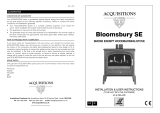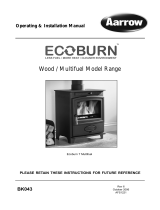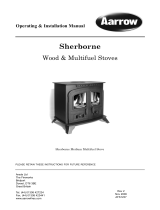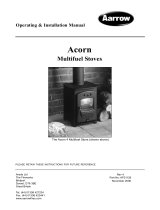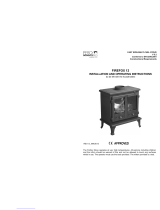Page is loading ...

Operating
and
Installation Instructions
CHARNWOOD
COUNTRY 4
Bishops Way, Newport, Isle Of Wight, PO3O 5WS, U.K.
Tel: (01983) 527552 Fax: (01983) 821267
Internet: www.charnwood.com Email: [email protected]

Before lighting the stove check with
the installer that the work and checks
described in the Installation
Instructions have been carried out
correctly and that the chimney has
been swept, is sound and free from
any obstructions.
FUELS
Wood
Wood must be dry and well seasoned.
Ideally it should be cut, split and
stacked under cover for at least a year
and preferably two years before being
burnt. Hard woods, such as Ash,
Beech and Oak are preferable to Soft
woods such as Pine.
The wood should be burnt in a bed of
ash on the flat base of the stove.
Burning wet unseasoned wood will
result in heavy tar deposits in the
chimney and reduced outputs.
Peat
Cut peat should be dried before
burning to reduce tar deposits. Peat
should be burnt in the same manner
as wood, on the flat base of the stove
in a bed of ash.
House Coal
Doubles, Trebles and Cobbles may be
burnt, do not use singles or coal dust
(or “slack”). Coal must only be burnt
with the optional coal kit, burning it
on the flat base of the stove may
cause damage. A little extra care is
needed when burning coal, please
refer to the section “Special Points
When Burning House Coal” later in
the instructions.
Smokeless Fuel
A wide variety of smokeless fuels are
available, many of which are suitable
for use on your Country 4. Some of
these are listed below:
Ancit
Anthracite Large Nuts
Centurion
Extracite
Homefire
Maxibrite
Phurnacite
Welsh Dry Steam Coal (Large Nuts).
Smokeless fuels must only be burnt
with the optional coal kit, burning it
on the flat base of the stove may
cause damage.
At first you may find it helpful to try
several fuels to find the most suitable.
If you are unable to obtain the fuel
you want ask your supplier, or an
approved fuel distributor to suggest
an alternative.
Only smokeless fuels may be burnt in
smoke control areas.
FITTING THE
OPTIONAL COAL KIT
Before burning coal or smokeless fuel
the coal kit must be fitted. This
consists of a grate, a coal retainer,
and an ashpan.
Remove the log retainer and place the
grate in the stove with the corner
cutouts at the front and with the
recesses underneath. Fit the coal
retainer and slide the ashpan in
under the grate.
LIGHTING
On initial lighting, the stove may
smoke and give off an odour as the
silicon paint with which the firebox
is painted reacts to the heat. This is
normal and will cease after a short
time, but meanwhile the room should
be kept well ventilated.
At first only light a small fire and
burn it slowly for two hours to allow
any residual moisture in the chimney
to evaporate.
IMPORTANT When burning wood
or peat on the base of the stove there
must be a bed of ash to prevent
damage to the base. When first
lighting the stove, if there is no ash
available then a make a layer of sand
or earth about 12mm (1/2 inch) thick
on the base to prevent any damage.
The stove may be lit using dry
kindling wood and paper or fire
lighters. Place the paper, or fire
lighters, and kindling on the base or
the grate and cover with a thin layer
of fuel. Open the spin wheel in the
door and open the airwash control
fully (see Fig. 1). Light the paper or
fire lighters. Close the door until the
fuel is well ignited then load with
fuel and adjust the air controls to the
required setting.
CHARNWOOD COUNTRY 4
OPERATING INSTRUCTIONS
Page 2
Country 4 7/98 b

When relighting the stove, leave the
ash on the base if burning wood or
peat, unless it is becoming too deep,
in which case some of it may be
removed. If burning solid fuel clear
the grate and empty the ashpan
before relighting.
CONTROLLING THE
FIRE
The rate of burning and hence the
output is controlled by the spin wheel
and the airwash control (see Fig. 1).
The spin wheel should be used when
lighting or when rapid burning is
required. It should not be left fully
open for long periods as this can
cause over-firing. For overnight
burning it should be closed.
The airwash control is used most of
the time to control the burning rate
and to keep the glass clean. Fully
extended gives full airwash for faster
burning and clean glass whereas fully
closed gives slow overnight burning.
It will not be possible to keep the
glass clean if this control is fully
closed, particularly immediately
after refuelling.
REFUELLING
Keep the firebox well filled but do
not allow fuel to spill over the top of
the fuel retainer.
Care should be taken, especially
when burning wood, that fuel does
not project over the fuel retainer or
damage to the glass may be caused
when the door is closed, it can also
cause the glass to black up.
ASH CLEARANCE
When burning wood or peat the ash
should be allowed to build up on the
base of the fire. It will only be
necessary to remove some ash once or
twice a week when it begins to
restrict the flow of air through the log
retainer.
When burning coal or smokeless fuel
the ashpan should be emptied
regularly before it becomes too full,
generally once or twice a day. Never
allow the ash to accumulate in the
ashpan so that it comes in contact
with the underside of the grate as this
will seriously damage the grate. Care
should be taken to ensure that ash is
cool before emptying it into plastic
liners or bins. After emptying the
ashpan, poke the fire with a poker to
clear the firebed of ash.
To make ash removal easier, when
burning coal or smokeless fuel, there
is a special Charnwood ash carrier
available. This enables the whole
ashpan to be placed in the sealed
carrier and taken outside. These may
be purchased from your supplier or,
in case of difficulty, directly from
ourselves.
SPECIAL POINTS
WHEN BURNING
HOUSE COAL
When loading the stove take care not
to smother the fire, instead fill the
firebox in two stages waiting between
each stage for the flames to appear
above the fire.
After a period of slumbering always
open the airwash control and wait
until flames appear above the fuel
bed before opening the door.
Burning coal will produce more soot
deposits than other fuels, especially if
the fire is run at low levels for long
periods. It is therefore vital to clean
the throat plate regularly, weekly
cleaning is recommended.
Never fully close the Airwash control
when burning coal.
RUNNING THE FIRE
WITH THE DOOR
OPEN
The fire may be run with the door
open if required. The more reactive
fuels, such as wood, peat, coal and
homefire, will burn better with the
door open than fuels like phurnacite
and ancit. Do not leave the fire
unattended with the door open.
OVERNIGHT
BURNING
For overnight burning the fire door
must be closed.
When burning wood load some large
logs on the fire and allow to burn for
half an hour before closing the spin
wheel, (this will help to reduce tar
deposits in the chimney.) Leave the
airwash control slightly open to help
keep the glass clear.
When burning coal or smokeless fuel,
if the fire is very low then open the
air controls and revive the fire,
adding a small amount of fuel if
necessary. Empty the ashpan and
poke the fire, load with fuel, and then
close the door spin wheel. The
airwash control may be kept slightly
open to help keep the door glass
clean.
Some experimentation may be
necessary to find the setting most
suitable for the type of fuel being
used and the draw on the chimney.
To revive the fire, empty the ashpan,
(if burning coal or smokeless fuel),
poke the fire, and open the air
controls to maximum. When the fire
is burning well load on more fuel as
necessary and adjust the air controls
Page 3
Country 4 7/98 b

to the desired setting.
CLEANING AND
MAINTENANCE
The stove is finished with a high
temperature paint which will
withstand the temperatures
encountered in normal use. This may
be cleaned with a damp lint-free cloth
when the stove is cold. Should
re-painting become necessary, high
temperature paints are available from
your supplier or from stove shops.
Most deposits on the glass may be
burnt off simply by running the fire
at a fast rate for a few minutes. If it
becomes necessary to clean the glass
then open the door and allow it to
cool. Clean the glass using a damp
cloth and then wiping over with a dry
cloth. Any stubborn deposits on the
glass may be removed with a
proprietary stove glass cleaner or
ceramic hob cleaner. Do not use
abrasive cleaners or pads as theses
can scratch the surface which will
weaken the glass and cause
premature failure.
THROAT PLATE AND
FLUEWAY CLEANING
It is important that the throat plate
and all the stove flueways are kept
clean in order to prevent potentially
dangerous fume emission. They
should be cleaned at least monthly,
and more frequently if necessary. It is
not necessary to let the fire out to
carry out these operations.
The front of the throat plate is pulled
forward and then lowered as shown
in Fig. 2. Any sooty deposits should
then be swept from the plate and into
the fire.
Return the throat plate to its correct
position - raise the front of the plate,
push it back and then lower it onto
the retaining lugs.
CHIMNEY SWEEPING
The chimney should be swept at least
twice a year. Where the top outlet or
vertical rear flue connector is used it
will generally be possible to sweep
the chimney through the appliance.
First remove the fuel retainer and the
throat plate. Then sweep the chimney
ensuring that soot is removed from
all horizontal surfaces after sweeping.
In situations where it is not possible
to sweep through the appliance the
installer will have provided
alternative means, such as a soot
door. After sweeping the chimney the
appliance flue outlet and the flue pipe
connecting the stove to the chimney
must be cleaned with a flue brush.
After clearing any soot from within
the stove, replace the throat plate (see
Fig. 2.) and the fuel retainer.
Different types of sweep’s brushes are
available to suit different flueways.
For standard brick chimneys a wire
centre sweep’s brush fitted with a
guide wheel is recommended. For
prefabricated insulated chimneys the
manufacturers instructions with
regard to sweeping should be
consulted.
TROUBLE SHOOTING
Fire Will Not Burn.
Check that:
a) the air inlet is not obstructed in
any way,
b) chimneys and flueways are clear,
c) that a suitable fuel is being used,
d) that there is an adequate air supply
into the room,
e) that an extractor fan is not fitted in
the same room as the stove.
f) there is sufficient draw in the
chimney. Once the chimney is warm
a draught reading of at least 2.5 mm
(0.10 inches) water gauge should be
obtained.
Door Glass Blacks Up
Differences in chimney draughts
mean that the best settings of the air
controls will vary for different
installations. A certain amount of
experimentation may be required,
however the following points should
be noted and with a little care should
enable the glass to be kept clean in
most situations:
a) Wet or unseasoned wood, or logs
overhanging the front fence will
cause the glass to blacken.
b) The airwash relies on a supply of
heated air to keep the glass clean,
therefore, when lighting the stove
allow the firebed to become well
established before closing the spin
wheel. This may also be necessary
when re-fuelling the stove.
c) When re-fuelling keep the fuel as
far back from the front fence as
possible, do not try to fit too much
fuel into the firebox.
d) Never completely close the airwash
control - as a guide it should be at
least a quarter open.
e) The spin wheel may be kept
slightly open to assist in keeping the
glass clean.
It is always more difficult to keep the
glass clean when running the stove
very slowly for long periods.
If blackening of the glass still occurs
check that all flue connections and
the blanking plate are well sealed. It
is also important that the chimney
draw is sufficient and that it is not
affected by down-draught.. When the
chimney is warm a draught reading
of at least 2.5 mm (0.10 inches)
water gauge should be obtained.
When burning coal some blackening
of the glass may occur below the
level of the coal retainer. This will
not obscure the view of the fire or
affect its performance.
Page 4
Country 4 7/98 b

Fume Emission.
Warning Note:
Properly installed and operated this
appliance will not emit fumes.
Occasional fume from de-ashing
and re-fuelling may occur.
Persistent fume emission is
potentially dangerous and must not
be tolerated. If fume emission does
persist, then the following
immediate actions should be taken:
a) Open doors and windows to
ventilate the room.
b) Let the fire out and safely
dispose of the fuel from the
appliance.
c) Check for flue or chimney
blockage, and clean if required.
d) Do not attempt to re-light the
fire until cause of fume has been
identified, if necessary seek
professional advice.
The most common cause of fume
emission is flueway or chimney
blockage. For your own safety these
must be kept clean.
Fire blazing out of
control
Check that :
a) The door is tightly closed.
b) The spin wheel is fully closed.
c) The airwash control is closed.
d) A suitable fuel is being used.
e) Door seals and airwash slide are
intact.
Chimney Fires.
If the chimney is thoroughly and
regularly swept, chimney fires should
not occur. However, if a chimney fire
does occur close the spin wheel and
the airwash control, and tightly close
the door of the appliance. This
should cause the chimney fire to go
out in which case the controls should
be kept closed until the stove has
gone out. The chimney and flueways
should then be cleaned. If the
chimney fire does not go out when
the above action is taken then the fire
brigade should be called immediately.
After a chimney fire the chimney
should be carefully examined for any
damage. Expert advice should be
sought if necessary.
Page 5
Country 4 7/98 b

a gap behind the stove of at least
75mm for access and to allow air to
enter the airwash inlets. The
positioning of the stove and the size
of the hearth are governed by
building regulations for Class 1
appliances. These building
regulations state that the hearth must
extend in front of the stove by at least
300mm (12 inches) and to the sides
of the stove by at least 150mm (6
inches). If in doubt as to the
positioning of the stove expert advice
should be sought either from the
supplier or the local building
inspector.
The fireplace must allow good
circulation of air around the
appliance to ensure that maximum
heat is transferred to the room and
also to prevent the fireplace from
overheating. A gap of 150mm (6
inches) each side and 300mm (12
inches) above the appliance should
give sufficient air circulation. If a
wooden mantelpiece or beam is used
in the fireplace it should be a
minimum of 460mm (18 inches), and
preferably 600mm (24 inches) from
the appliance. In some situations it
may be necessary to shield the beam
or mantelpiece to protect it.
CONNECTIONS TO
FLUES
The stove must be connected to the
flue using 125mm (5") i/d pipe. This
may be stainless steel, cast iron, or
thick wall steel pipe. Straight lengths
of Charnwood Pipe to match the
stove are available if required.
There are several ways of connecting
the stove to the flue. These are
illustrated in Figs. 3 to 6.
If the optional vertical rear flue
connector is used then the chimney
may be swept through the appliance.
Horizontal lengths of flue must be
HEALTH AND SAFETY
PRECAUTIONS
Please take care when installing the
stove that the requirements of the
Health and Safety at Work Act 1974
are met.
Some types of fire cement are caustic
and should not be allowed to come
into contact with the skin. In case of
contact wash with plenty of water.
If there is a possibility of disturbing
any asbestos in the course of
installation then please use
appropriate protective equipment.
There must not be an extractor fan
fitted in the same room as the stove
as this can cause the appliance to
emit fumes into the room.
There must be an adequate air supply
into the room in which the appliance
is installed totalling at least 100
square cm. (16 square inches) to
provide combustion air.
In addition to these instructions the
requirements of BS.8303 and
BS.6461 Pt 1&2; 1984 must be
fulfilled. Local Authority Bylaws and
Building Regulations regarding the
installation of Solid Fuel burning
appliances, flues and chimneys must
also be observed.
PERFORMANCE
The output of the Country 4 is 4.0
kW (13,648 Btu/h). This output is
based on a 2 hourly re-fuelling cycle
burning seasoned hardwood logs, or a
4 hourly re-fuelling cycle burning
smokeless fuel.
CHIMNEY
In order for the appliance to perform
satisfactorily the chimney height
must not be less than 4 metres
measured vertically from the outlet of
the stove to the top of the chimney.
The internal dimensions of the
chimney should preferably be 175
mm (7 inches) or 200mm (8 inches)
either square or round and MUST
NOT BE LESS THAN 125 mm (5
INCHES).
If an existing chimney is to be used it
must be swept and checked, it must
be in good condition, free from
cracks and blockages, and should not
have an excessive cross sectional
area. If you find that the chimney is
in poor condition then expert advice
should be sought regarding the
necessity of having the chimney
lined. If it is found necessary to line
the chimney then a lining suitable for
Solid Fuel must be used.
If there is no existing chimney then a
prefabricated block chimney or a twin
walled insulated stainless steel flue to
BS.4543 can be used either internally
or externally. These chimneys must
be fitted in accordance with the
manufacturers instructions and
Building Regulations.
Single wall flue pipe is suitable for
connecting the stove to the chimney
but is not suitable for using for the
complete chimney.
If it is found that there is excessive
draw in the chimney then a draught
stabiliser should be fitted.
It is important that there is sufficient
draw in the chimney and that the
chimney does not suffer from
down-draught. When the chimney is
warm the draw should be not less
than 2.5mm (0.10 inches) water
gauge. If in doubt about the chimney
seek expert advice.
HEARTH AND FIRE
SURROUND
The stove must stand on a fireproof
hearth and must be situated at least
300mm (12 inches) from any
combustible material. There must be
CHARNWOOD COUNTRY 4 INSTALLATION
INSTRUCTIONS
Page 6
Country 4 7/98 b

Also check all joints and seals. On
completion of the installation and
commissioning please leave the
operating instructions with the
customer and advise them on the use
of the appliance.
kept to a minimum and should not be
more than 125mm (5 inches) long.
The sealing face of the flue collar
must be coated with fire cement
before fixing to the body of the stove
using the two screws provided. The
blanking plate must be removed,
sealed with fire cement and refitted,
care being taken to ensure that the
fold on the clamping plate is in line
with the lugs on the firebox as shown
in Fig. 7. Ensure that the clamping
plate does not prevent the throat plate
from seating correctly. All flue
connections must be well sealed.
SOOT DOORS
It is possible to pass a 16 inch
diameter sweeps brush through the
appliance but in most back outlet
installations it will be necessary to
have a soot door to enable the
chimney to be swept. The optional
vertical rear flue connector does
allow the chimney to be swept
through the stove.
Soot doors may either be in the actual
brickwork of the chimney or in the
register plate. Various positions of
soot doors are shown in Figs. 3 to 6.
PRE LIGHTING
CHECK
Ensure that the throat plate is fitted
in the roof of the appliance. The
location and positioning of the throat
plate is shown in Fig. 2.
Check that the front fence is fitted
correctly and that the door closes
properly.
COMMISSIONING
On completion of the installation
allow a suitable period of time for the
fire cement and mortar to dry out
before lighting the fire. If no grate is
fitted make a layer of ash or sand on
the base of the stove before lighting.
Check to ensure that smoke and
fumes are taken from the appliance
up the chimney and emitted safely.
Page 7
Country 4 7/98 b

Overall Dimensions
(All dimensions are in mm)
Page 8
Country 4 7/98 b
/
